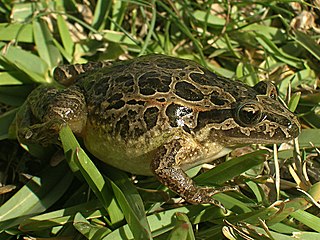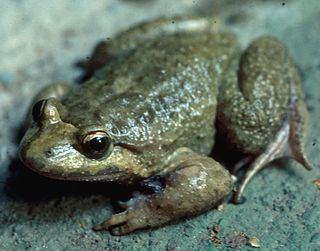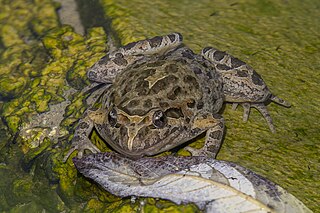
Arthroleptis tanneri, the Tanzania screeching frog or Tanner's squeaker, is a species of frog in the family Arthroleptidae. It is endemic to the West Usambara Mountains in northeastern Tanzania; previous records from elsewhere refer to other species.
Ansonia torrentis, also known as the Gunung Mulu stream toad and torrent slender toad, is a species of toad in the family Bufonidae. It is endemic to Mount Mulu in Sarawak, Borneo (Malaysia). The specific name torrentis refers to the habitat at its type locality, a stream running down a steep mountainside.

The Iberian painted frog is a species of frog in the family Alytidae. It is found in Portugal and Spain, where its natural habitats are temperate forests, temperate shrubland, Mediterranean-type shrubby vegetation, rivers, intermittent rivers, swamps, freshwater marshes, intermittent freshwater marshes, sandy shores, arable land, and grassland. It is threatened by habitat loss.

The Corsican painted frog is a species of frogs in the family Alytidae.

The Tyrrhenian painted frog is a species of frog in the family Alytidae.

The Chamula mountain brook frog is a species of frog in the family Hylidae endemic to Chiapas, Mexico. Its natural habitats are moist montane forests. It is threatened by habitat destruction and has been rated as "endangered" by the IUCN.

Sarcohyla labeculata is a species of frog in the family Hylidae. It is endemic to the Sierra Mixe in Oaxaca, Mexico. This species was resurrected from synonymy of Sarcohyla bistincta in 2018, while at the same time bringing Sarcohyla calthula and Sarcohyla ephemera in its synonymy. Common name Mixe streamside treefrog has been proposed for this species, whereas the common names yellow-robed treefrog and Cerro Las Flores spikethumb frog referred to the former S. calthula and S. ephemera, respectively.
Hyperolius pseudargus, also known as the Mette's reed frog, is a species of frogs in the family Hyperoliidae. It is endemic to south-central Tanzania and occurs in the Udzungwa Mountains and south to Njombe in the Southern Highlands. Male Hyperolius pseudargus greatly resemble Hyperolius argus but have less webbing between the toes and the male advertisement call is different. The vernacular name refers to Mette Westergaard, Danish biologist who collected the holotype and is the junior describer of this species.

Leptopelis parkeri is a species of frog in the family Arthroleptidae. It is endemic to Tanzania and known from the Eastern Arc Mountains. Specifically, it has been recorded from Uluguru, Udzungwa, East and West Usambara, Nguru, and South Pare Mountains. Common names Parker's tree frog and Parker's forest treefrog have been coined for it. It is named after Hampton Wildman Parker, a British zoologist and herpetologist from the Natural History Museum, London.
Craugastor adamastus is a species of frog in the family Craugastoridae. It is endemic to Guatemala and only known from its type locality near Aldea Vista Hermosa, on the northern slopes of the eastern portion of the Sierra de las Minas, where the type series was collected in 1980–1981.
Sphenophryne coggeri is a species of frog in the family Microhylidae. It is endemic to New Guinea and known from two regions in Papua New Guinea, one in the Madang Province and the other in the Southern Highlands Province. The specific name coggeri honors Harold Cogger, a herpetologist from the Australian Museum.
Phrynobatrachus irangi is a species of frog in the family Phrynobatrachidae. It is endemic to Kenya and is known only from two localities, its type locality, the eponymous Irangi Forest on the south-eastern slopes of Mount Kenya, and Kimande on the south-eastern slopes of the Aberdare Range. Common name Irangi puddle frog has been coined for it.
Cornufer malukuna, commonly known as the Malukuna webbed frog, is a species of frog in the family Ceratobatrachidae. It is endemic to Guadalcanal Island, Solomon Islands. The specific name malukuna refers to its type locality, Malukuna.
Cornufer macrops, also known as the Aresi wrinkled ground frog, is a species of frog in the family Ceratobatrachidae. The specific name macrops refers to the very large eyes of this species. It is endemic to Bougainville Island, in the Papua New Guinean part of the Solomon Islands archipelago. It is only known from the mountains of northern Bougainville Island, near Kunua, although its true range could be much wider.

Raorchestes parvulus is a species of frog in the family Rhacophoridae. It is found from eastern Bangladesh east through Myanmar and Thailand to Cambodia, northern Vietnam, Laos, and Peninsular Malaysia. Its distribution might well extend into northeastern India and southern China. This species was first described by George Albert Boulenger based on seven specimens collected by Leonardo Fea from Karen Hills, Burma.

Discoglossus pictus, the Mediterranean painted frog or simply painted frog, is a species of frog in the family Alytidae.
Chalcorana parvaccola is a species of "true frog" in the family Ranidae. It is endemic to Sumatra, Indonesia. It was split off from Chalcorana chalconota by Robert Inger and colleagues in 2009, along with a number of other species. The specific name parvaccola is derived from Latin parvus meaning small and accola meaning neighbor, and refers to this species being smaller than its "neighbor", the related Sumatran species Chalcorana rufipes.
Chalcorana rufipes is a species of "true frog" in the family Ranidae. It is endemic to Sumatra, Indonesia. It was split off from Chalcorana chalconota by Robert Inger and colleagues in 2009, along with a number of other species. The specific name rufipes is derived from Latin rufus meaning reddish and pes meaning foot, in reference to the reddish tinge on the underside of the pedal webbing in life.
Mantophryne axanthogaster is a species of frog in the family Microhylidae. It is endemic to Sudest Island, a part of Louisiade Archipelago in the Milne Bay Province of Papua New Guinea.











